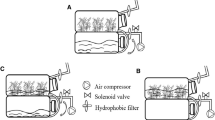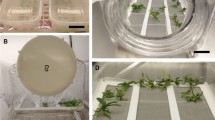Abstract
Corema album is one of the two species of flowering plants in the Corema genus, from family Ericaceae, and is also known for its common name Camarinha or Portuguese crowberry. It has a restricted distribution, being confined to the western Atlantic coast of the Iberian Peninsula and Aquitaine in France, in dune systems or in low pine forests. The shrub is exploited because of its food, ornamental and medicinal value and the regeneration rate in the natural habitat is very low. For the first time, an in vitro propagation protocol has been developed from nodal segments obtained from adult plants in the field. Several nutrient formulations were tested for the establishment and the best results, in terms of highest bud break frequency (6.7%), were achieved with the woody plant medium (WPM) basal salts, supplemented with 2.0 mg l−1 2iP at pH 5.6. WPM was then used for sub-culturing of shoots every 8 weeks and to perform an assay to test the effect of different cytokinins (BA, Kin 2iP and mT) combinations in the multiplication phase. Of all the combinations tested, 2.0 mg l−1 2iP with 1.0 mg l−1 Kin is the most beneficial with 100% bud break, 6.8 new shoots, with 14.2 mm average length and the shoots regenerated were healthy. A study with a temporary immersion bioreactor (SETIS™) was performed, with promises results, where more than double the multiplication rate was achieved compared with the previous semisolid medium. However, in this system, vitrification processes have occurred which may compromise the viability of the shoots. Rooting, which proved to be a difficult process, was best induced ex vitro by dipping of the microshoots in a 2.0 g l−1 IBA solution for 10 s, followed by placement in jiffy-7C pellets, with 20% of rooting and an average of 5.3 roots and 43.8 mm long. The microplants were potted and acclimatized, showed 100% survival.
Key message
Corema album, exploited because of its food, ornamental and medicinal value, has a restricted distribution and a very low regeneration rate in the natural habitat. For the first time, an in vitro regeneration protocol has been developed from nodal segments obtained from adult plants in the field which is promising for a future programme of breeding and valorisation of this species.


Similar content being viewed by others
References
Álvarez-Cansino L, Zunzunegui M, Barradas MCD (2017) Germination and clonal propagation of the endemic shrub Corema album, a vulnerable species with conservation needs and commercial interest. Nat Prod Commun 12:267–272. https://doi.org/10.1177/1934578X1701200233
Andrade SC, Gonçalves F, Guiné RPF (2017) Contribution for the physical-chemical characterization of portuguese crowberry (Corema album). Int J Food Sci Nutr 2(4):9–14
Annapurna D, Rathore TS (2010) Direct adventitious shoot induction and plant regeneration of Embelia ribes Burm F. Plant Cell Tiss Org Cult 101:269–277. https://doi.org/10.1007/s11240-010-9684-x
Arab MA, Yadollahi A, Shojaeiyan A, Shokri S, Ghojah SM (2014) Effects of nutrient media, different cytokinin types and their concentrations on in vitro multiplication of GxN15 (Hybrid of Almond x Peach) vegetative rootstock. J Genet Eng Biotechnol 12:81–87. https://doi.org/10.1016/j.jgeb.2014.10.001
Benmahioul B, Dorion N, Kaid-Harche M, Daguin F (2012) Micropropagation and ex vitro rooting of pistachio (Pistacia vera L.). Plant Cell Tiss Org Cult 108:353–358. https://doi.org/10.1007/s11240-011-0040-6
Calviño-Cancela M (2002) Spatial patterns of seed dispersal and seedling recruitment in Corema album (Empetraceae): the importance of unspecialized dispersers for regeneration. J Ecol 90:775–784. https://doi.org/10.1046/j.1365-2745.2002.00711.x
Calviño-Cancela M (2004) Ingestion and dispersal: direct and indirect effects of frugivores on seed viability and germination of Corema album (Empetraceae). Acta Oecol 26:55–64. https://doi.org/10.1016/j.actao.2004.03.006
Calviño-Cancela M (2005) Fruit consumer and seed dispersers of the rare shrub Corema album, Empetraceae in coastal sand dunes. Rev d’Écologie (Terre Vie) 60:97–106
Clavijo A, Diaz-Barradas MC, Ain-Lhout F, Zunzunegui M, Correia O (2002) A fragmentação como causa principal da redução do habitat de Corema album na sua área de distribuição. Rev Biol 20:109–120
Clavijo A, Díaz-Barradas MC, Zunzunegui M, Ain-Lhout F, Álvarez-Cansino L, García-Novo F (2003) A conservação de Corema album no litoral atlântico da Península Ibérica; a influência de dispersores animais na regeneração natural. Rev Biol 21(43):56
Cüce M, Sökmen A (2015) Micropropagation of Vaccinium myrtillus L. (Bilberry) naturally growing in the turkish flora. Turk J Biol 39:233–240. https://doi.org/10.3906/biy-1406-25
Cüce M, BektaŞ E, Sökmen A (2013) Micropropagation of Vaccinium arctostaphylos L. via lateral-bud culture. Turk J Agric For 37:40–44. https://doi.org/10.3906/tar-1204-31
Debnath SC (2004) Clonal propagation of dwarf raspberry (Rubus pubescens Raf.) through in vitro axillary shoot proliferation. Plant Growth Regul 43:179–186. https://doi.org/10.1023/B:GROW.0000040110.53216.6a
Debnath SC (2011) Bioreactors and molecular analysis in berry crop micropropagation—a review. Can J Plant Sci 91:147–157. https://doi.org/10.4141/cjps10131
Diaz-Barradas MC, Costa C, Correia O, León-González AJ, Navarro-Zafra I, Zunzunegui M, Alvarez-Cansino L, Martín-Cordero C (2016) Pentacyclic triterpenes responsible for photoprotection of Corema album (L.) D.Don white berries. Biochem Syst Ecol 67:103–109. https://doi.org/10.1016/j.bse.2016.05.009
Dobránszki J, Teixeira da Silva JA (2010) Micropropagation of apple—a review. Biotech Adv 28:462–488. https://doi.org/10.1016/j.biotechadv.2010.02.008
Elmaghabi AM, Hammud S, Abugnia E (2017) In vitro plant regeneration of libyan wild plants: edible species (Arbutus pavarii) and endanger species [Haplophyllum tuberculatum (Forsk.) Juss]. J Aegean Agric Res Inst 27:127–132
Fedriani JM, Delibes M (2009) Functional diversity in fruit-frugivore interactions: a field experiment with mediterranean mammals. Ecography 32:983–992. https://doi.org/10.1111/j.1600-0587.2009.05925.x
Font-Quer P (1990) Plantas Medicinales. El Dioscorides Renovado, Labor Barcelona
Gomes F, Simões M, Lopes ML, Canhoto JM (2010) Effect of plant growth regulators and genotype on the micropropagation of adult trees of Arbutus unedo L. (strawberry tree). New Biotech 27:882–892. https://doi.org/10.1016/j.nbt.2010.02.009)
Gonçalves JC, Diogo MG, Amâncio S (1998) In vitro propagation of chestnut (Castanea sativa x C. crenata): effects of rooting methods on plant survival, peroxidase activity and anatomical changes during root formation. Sci Hortic 72:265–275. https://doi.org/10.1016/S0304-4238(97)00136-2
Huang PL, Liao LJ, Tsai CC, Liu ZH (2011) Micropropagation of bromeliad Aechmea fasciata via floral organ segments and effects of acclimatization on plantlet growth. Plant Cell Tissue Organ Cult 105:73–78. https://doi.org/10.1007/s11240-010-9843-0
Jesionek A, Kokotkiewicz A, Wlodarska P, Zabiegala B, Bucinski A, Luczkiewicz M (2017) Bioreactor shoot cultures of Rhododendron tomentosum (Ledum palustre) for a large-scale production of bioactive volatile compounds. Plant Cell Tissue Organ Cult 131:51–64. https://doi.org/10.1007/s11240-017-1261-0
Kevers C, Franck T, Strasser RJ, Dommes J, Gaspar T (2004) Hyperhydricity of micropropagated shoots: a typically stress-induced change of physiological state. Plant Cell Tissue Organ Cult 77:181–191. https://doi.org/10.1023/B:TICU.0000016825.18930.e4
Larrinaga AR, Guitián P (2016) Intraspecific variation in fruit size and shape in Corema album (Ericaceae) along a latitudinal gradient: from fruits to populations. Biol J Linn Soc 118:940–950. https://doi.org/10.1111/bij.12794
León-Gonzáles A, Truchado P, Tomás-Barberán F, López-Lázaro M, Barradas MCD, Martín-Cordero C (2013) Phenolic acids, flavonols and anthocyanins in Corema album (L.) D. Don berries. J Food Compos Anal 29:58–63. https://doi.org/10.1016/j.jfca.2012.10.003
León-González AJ, Mateos R, Ramos S, Martín MA, Sarriá BC, Martín-Cordero C, López-Lázaro M, Bravo L, Goya L (2012) Chemo-protective activity and characterization of phenolic extracts from Corema album. Food Res Int 49:728–738. https://doi.org/10.1016/j.foodres.2012.09.016
Martins JPR, Schimildt ER, Alexandre RS, Santos BR, Magevski GC (2013) Effect of synthetic auxins on in vitro and ex vitro bromeliad rooting. Pesqui Agropecu Trop 43(2):138–146. https://doi.org/10.1590/S1983-40632013000200009
Monteiro TR, Freitas EO, Nogueira GF, Scherwinski-Pereira JE (2018) Assessing the influence of subcultures and liquid medium during somatic embryogenesis and plant regeneration in oil palm (Elaeis guineensis Jacq.). J Hortic Sci Biotechnol 93(2):196–203. https://doi.org/10.1080/14620316.2017.1360156
Murashige T, Skoog F (1962) A revised medium for rapid growth and bioassays with tobacco tissue cultures. Physiol Plant 15:473–497
Oliveira PB, Dale A (2012) Corema album (L.) D. Don, the white crowberry-a new crop. J Berry Res 2:123–133. https://doi.org/10.3233/JBR-2012-033
Paek KY, Hahn EJ, Son SH (2001) Application of bioreactors for large-scale micropropagation systems of plants. In Vitro Cell Dev Biol-Plant 37:149–157. https://doi.org/10.1007/s11627-001-0027-9
Pereira MJ (2006) Conservation of Vaccinium cylindraceum Smith (Ericaceae) by micropropagation using seedling nodal explants. In Vitro Cell Dev Biol-Plant 42:65–68. https://doi.org/10.1079/IVP2005720
Saiju HK (2006) Tree tissue culture and ex vitro sand rooting for reforestation. In: Suzuki K, Ishi K, Sakurai S, Sasaki S (eds) Plantation technology in tropical forest science. Springer, Berlin, pp 151–154
Shekafandeh A, Shahcheraghi ST (2017) Ex vitro rooting and survival of regenerated shoots from three fig (Ficus carica L.) genotypes. Agriculturae Conspectus Scientificus 82:383–387
Sreedhar RV, Venkatachalam L, Neelwarne B (2009) Hyperhydricity-related morphologic and biochemical changes in Vanilla (Vanilla planifolia). J Plant Growth Regul 28:46–57. https://doi.org/10.1007/s00344-008-9073-4
Vujović T, Ružić D, Cerović R (2012) In vitro shoot multiplication as influenced by repeated subculturing of shoots of contemporary fruit rootstocks. Hort Sci 39(3):101–107
Yan H, Liang C, Yang L, Li Y (2010) In vitro and ex vitro rooting of Siratia grosvenorii, a traditional medicinal plant. Acta Physiol Plant 32:115–120. https://doi.org/10.1007/s11738-009-0386-0
Zróbek-Sokolnik A, Ślipiko A, Kucewicz M, Milewicz M, Hołdyński C (2011) Micropropagation of Chamaedaphne calyculata (L.) Moench by direct shoot organogenesis. Pol J Natur Sci 26(3):207–215
Acknowledgements
This study was co-financed by Programa Operacional EP-INTERREG V A Espanha-Portugal (POCTEP), Projeto 0665_COOP4PAM_4_P and national founds from FCT, Fundação para a Ciência e Tecnologia UID IPCB-CERNAS Project UID/AMB/00681/2013.
Author information
Authors and Affiliations
Corresponding author
Additional information
Communicated by Wagner Campos Otoni.
Publisher's Note
Springer Nature remains neutral with regard to jurisdictional claims in published maps and institutional affiliations.
Rights and permissions
About this article
Cite this article
Alves, V., Pinto, R., Debiasi, C. et al. Micropropagation of Corema album from adult plants in semisolid medium and temporary immersion bioreactor. Plant Cell Tiss Organ Cult 145, 641–648 (2021). https://doi.org/10.1007/s11240-021-02034-1
Received:
Accepted:
Published:
Issue Date:
DOI: https://doi.org/10.1007/s11240-021-02034-1




